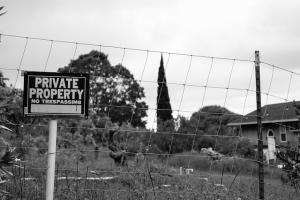
(Let the reader beware, this is an unpleasant spooky ghost story in the Gothic haunted house tradition, rewritten for suburbia when I was having anxiety. Any resemblance to actual persons, living, dead or undead, or actual events, is purely coincidental. All persons attempting to find a moral in it will be ridiculed.)
There was no tenant in the last house on Michaelmas Avenue. There was no lease, and certainly no second-story apartment, because there was no second story. At least, there wasn’t before the new owners moved in. There was the day after.
The houses on Michaelmas Avenue were all variations on the same design, a respectable L-shaped three-bedroom ranch house from the dawn of the Baby Boom. Some faced north and some were flipped around the other way, like the bricks in a Tetris game, but they were all the same shape. Some had a screened-in porch on the back, fattening the small end of the L; some had no porch, but a free-standing bench swing in the yard. Each had a large bay window in the living room, shielded by thick white drapes. One of the houses on Michaelmas Avenue had faux stone on the façade; one had brick, and the rest were just siding in various neutral colors.
Not one of them had a second story.
The house at the end of the street was no different, except that it had been vacant for as long as I’d lived there. My wife, May, said it was the size of the yard—Michaelmas Avenue ran downhill before hitting a steep ravine. Each of the other houses was built in the center of an identical postage stamp of lawn, but the house at the literal edge of Michaelmas Avenue bordered the ravine. It had a small side yard rather than a back yard. Instead of a porch or a free-standing swing, there was an old-fashioned brick fire pit with weeds growing straight up out of the chimney. The trees that grew in the ravine overhung the yard, shading it; lawn did not grow there, but only moss and matted tangles of burrs.
The house itself was gray. Most of the windows were cracked; the big picture window revealed a set of drab, yellowing drapes hung with spider webs. The roof was charcoal-colored shingle—I had noted that roof many times. The shingles used to peel off a few at a time whenever we had a windy night, and I’d find them on the sidewalk when I went for a walk the next morning. I’d reflexively look up at the roof, to see if I could find the bare patch.
That’s what I was doing when I noticed the second story. We’d all seen that the “for sale” sign had been taken down, but we didn’t think the house had been sold. There was no reason for it to be sold. There were two other houses of that identical design, in much better shape, further up Michaelmas Avenue. May said the bank that owned it must have given up.
That night, the wind blew hard. It blew open locked doors and knocked down valuable trees. One respectable house had its bay window smashed by a flying trash can lid, but nobody was hurt as far as anyone knew.
I walked past the house at edge of Michaelmas Avenue. The sidewalk was dotted with bits of stripped-off shingle, so I looked to the roof.
That’s when I saw the second story.
The roof had a higher slope than it had had before, and there was an odd little dormer with three dark window panes facing the street.
The siding on the dormer, and the smudged glass, looked just as old as the rest of the house. I could see shingles missing on the newly sloped roof. The house had sprouted a second story that matched it perfectly.
That was the first thing I noticed. Next, I noticed that the bay window’s drapes were missing. I could see inside the house, though there wasn’t much to see— walls that had once been white, and a glimpse of the window on the back of the house.
I walked past slowly; that was when I saw the staircase against the side of the house, where the odd little yard was. There was a splintery, worn wooden staircase with a treacherously thin rail, leading up to a door in that new second story which hadn’t been there a day ago.
There was another, small window in the door at the top of the stairs. There were yellowed curtains over the window, the same shade as the drapes that had been in the bay window downstairs. For just a second, I thought I saw the curtains twitch as if someone had moved them—as if someone was in there, drawing them back to look at me.
“Howdy,” said a voice.
I jumped.
There was a young woman standing at the kitchen door beside the new stairs. She had copper hair I could barely see, beneath a dust-covered bandanna; her face was streaked with dust as well, and shiny with sweat. Her plaid flannel shirt and paint-stained jeans were dusty as well. In the early light, she looked metallic, alien.
Her demeanor was friendly, however. “You must be the new neighbor!”
“I live three houses down,” I said.
“Ah!” she smiled. “Maybe you can help. Now, looks to me like all these houses are the same construction. You got a basement in yours?”
I didn’t know what kind of accent she had—a pleasant one, vaguely Southern and a little old-fashioned. Her voice was loud, but friendly.
“Yes,” I said. “My basement door’s in the kitchen.”
“Same as mine, good. I’m trying to find where they hid the breaker box. I blew a fuse running the shop vac. The basement’s pitch black. Dropped my flashlight on the stairs and I now I can’t find it either. But I figure if someone tells me where to look, I can at least feel around and throw the breakers back on.’
“It’s… it’s toward the back.” I tried to think how to describe every basement on this street—the nice dry carpeted room that was usually used as a den, the laundry room next to it with a hard tile floor. “It’s in the back of the utility closet… can I just come in and show you?”
The woman stepped aside and ushered me in with one dirty hand.
The kitchen was worse than I thought—twilit by a square of sunshine coming in from the door, blinds carefully closed at the windows; the bare bulb in the ceiling was dark. There was textured wallpaper that had once been salmon pink, now speckled with a mural of variegated mildew, on all of the walls; the cupboards were blond particle board, warped from moisture. The sour smell of mold was overwhelming; it made my eyes sting.
“Ain’t a pretty sight,” said the woman casually. “We’re gonna pull everything out and start over. Can’t turn the water on til someone fixes the pipes, but at least we’ve got electric.”
My eyes wandered to the counter; there was a drill there, a bucket of nails and a stack of papers. The one on top looked like renter’s lease; where the name of the landlord should be, there was were two bold-print words, not capitalized as if they were anybody’s name: “vichnaya pamyat.”
“Are you… renting this place?”
“Nah. But the tenant upstairs still has a lease. It’s how we got it so cheap.”
“There’s a tenant?”
“She’s gonna be here a long time.”
The woman strode ahead of me to the basement door, which was hanging open without a knob.
I noticed for the first time how tall she was—over six feet, taller than most men. Her head nearly hit the doorpost as she went down the stairs.
There were no windows at all in the basement. The only light was coming from the door at the top of the stairs, behind me, and that seemed to be swallowed very quickly in the musty air. I didn’t want to follow her into that abyss, but then I heard a noise upstairs, in the aged and weathered second story that hadn’t been there yesterday.
Footsteps.
Somebody was walking, slowly, above the kitchen, squeaking every board as they went.
I went downstairs.
“At the back of the bigger room, there should be a closet?” I directed, just as the woman got to the bottom of the steps.
She turned aside and crouched. “Think I saw my flashlight. You go ahead, I’ll see if I can get it working for us.”
I stepped forward into the blackness, my hands in front of my face, to where the rec room would be if it were my house. Three steps and I hit a wall—a soaking wet plaster wall.
The footsteps began again—the very same sound; heavy, plodding footsteps, squeaking every board, but now they were above the basement, just a little way over my head.
My hand felt the wall for the door frame I expected to find, but it wasn’t there. The fuse box wasn’t there either, just a hard, rough, smelly wall of plaster that left cold moisture all over my hand.
“Keeps rolling away from me,” said the woman in that same boisterous, happy voice. “Shouldn’t be long.”
My fingers brushed over a patch where the wall was pitted; I felt something tickle against my palm. I jerked away.
I’ve always been terrified of insects crawling out of the holes in walls. Insects that flew through the air or crawled on the ground never bothered me; I regularly caught live spiders for May and released them in the garden. But I couldn’t stand the thought of an insect poking its head out of a burrow. May had looked that up one day; she told me it was called tripopophobia, and it wasn’t uncommon.
That was the worst thing about May: she was always trying to tell me what was wrong with me. After she looked up tripopophobia I tried to pretend that I wasn’t afraid of burrowing insects after all—that lasted a few weeks, until I discovered the carpenter ants in the wood shed. May never let me hear the end of that. She never let me hear the end of anything. She wouldn’t let me forget.
There, in the basement of the last house on Michaelmas Avenue, with no light, no door where it ought to be and that tenant squeaking the floor boards upstairs, I panicked. Next thing I knew I was on my hands and knees on the cold cement floor.
“You all right?” said the woman.
The insect tickled again, this time on the back of my hand. I slapped; it tickled on my wrist. I grabbed my wrist and then I felt the mildest of stings—one on the inside of my wrist and one, two, three, four on the back.
Just as I screamed, the flashlight blinked on.
I could not find the insect anywhere.
The door was a few feet to the left of where I’d been feeling the wall. I went inside and opened the breaker box; the lights all came flickering back on, as commonplace and unalarming as everything else on Michaelmas Avenue. I was in the damp unfinished basement of a 1950s ranch house, with a dusty landlady aiming a dim flashlight at my back.
“What bit you?” she asked conversationally.
There were no marks on my wrist; or, at least, I couldn’t see any in the twilight of the basement. “I guess it was nothing.”
“Well,” she said, turning back to the steps, “You’ve been very helpful. Let’s get outa this place.”
There was nobody in the smelly kitchen. The tenant who hadn’t been there yesterday must have gone back to the upstairs apartment that had appeared overnight.
“Come again,” said my new neighbor.
“Thank you, Miss…”
“Vichnaya Pamyat,” said the woman in an odd tone. “Is there something you’re forgetting, Kade?”
I couldn’t think of anything, except that I hadn’t remembered telling her my name.

















